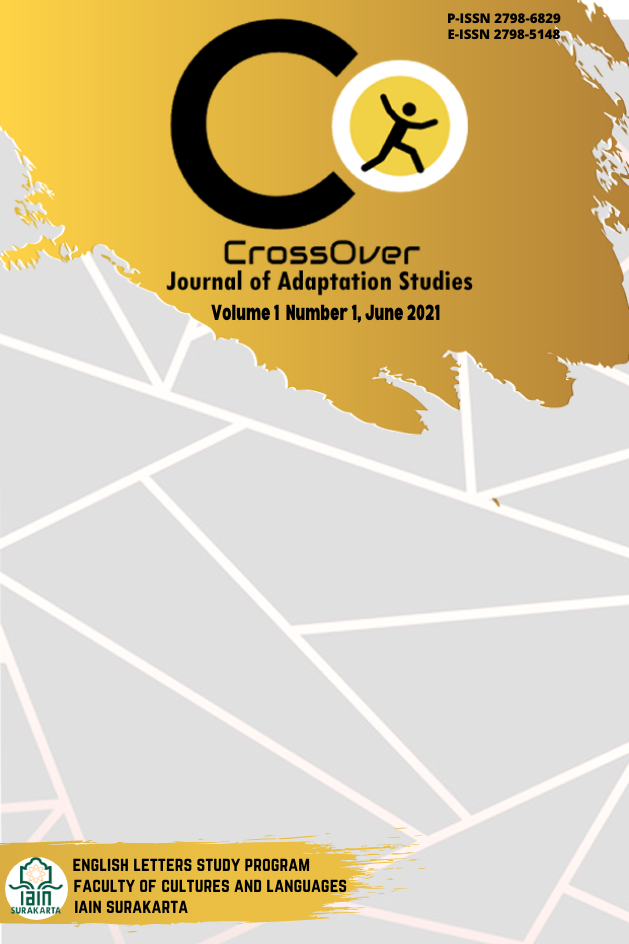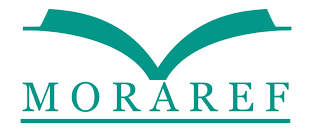INTERTEXTUALITY OF THE SAGAS OF RAGNAR LODBROK BY BEN WAGGONER AND ITS TV-SERIES VERSION: VIKINGS (SYMBOLIC INTERACTIONISM APPROACH)
DOI:
https://doi.org/10.22515/crossover.v1i1.3732Abstract
Abstract
Mythical and historical stories were mushroomingly adapted into movies. However, intertextuality is proven to be an obstacle in the adaptation process since adaptation might trigger losses on the meaning of the original works.Addressing this issue, this descriptive qualitative research attempts to reveal (1) the types of intertextuality found from the Sagas of Ragnar Lodbrok by Ben Waggoner and its TV-Series Version: Vikings through the characterization of Ragnar Lodbrok, (2) how is intertextuality presented in the Sagas of Ragnar Lodbrok by Ben Waggoner and its TV-Series Version: Vikings through the characterization of Ragnar Lodbrok. Intertextuality theory by Fitzsimmons (2013) and characterization theory by Bernardo (2015) were applied to answer these problems. The data of this research were words, phrases, clauses, sentences, and visualizations, considered to reflect the characters of the story. The data were taken from the Sagas of Ragnar Lodbrok and Vikings TV series. The data were analyzed by employing Spradley’s componential analysis. Symbolic Interactionism approach was applied in this research to reveal how characters were treated as a symbolic meaning in intertextual domain. Derived from the analysis, this research unveils three types of intertextuality namely optional, obligatory, and accidental. The data shows that optional intertextuality is the most common type of intertextuality found from this research. Characterization of Ragnar was intertextually presented through thirteen manners or types with what others say and physical visualization as the recurring types. These findings indicate that a shift on perspective occurs. This shift signifies how Ragnar Lodbrok is differently treated to meet the distinctive features of the media in which the story occurs and the users of the media.
Key words: Intertextuality, Ragnar Lodbrok, Characterization, Symbolic Interactionism
Downloads
References
Aksan, N., Kısac, B., Aydın, M., & Demirbuken, S. (2009). Symbolic interaction theory. Procedia-Social and Behavioral Sciences, 1(1), 902-904.
Allen, G. (2011). Intertextuality. Routledge.
Baetens, J., & Sánchez-Mesa, D. (2015). Literature in the expanded field: intermediality at the crossroads of literary theory and comparative literature. Interfaces. Image Texte Language, (36).
Barthes, R. (2001). “From Work to Text”, The Norton Anthology of Theory and Criticism,(Ed. Vincent B. Leitch. Et al.). W. W. Norton and Company, New York and London, pp.1470.
Barthes, R. (2001). “The Death of the Author”. The Norton Anthology of Theory andCriticism. (Ed. Vincent B. Leitch. Et al). W. W. Norton & Company, New York and London, pp.1466-1470.
Bernardo, K. (2015). Types of Characters in Fiction.
Blumer, H. (1962). Society as symbolic interaction. Contemporary Sociological Thought, 91.
Blumer, H. (1986). Symbolic interactionism: Perspective and method. Univ of California Press.
Brown, Blain. (2002). Cinematography: Theory and Practice. Routledge.
Creswell, John W. Educational Research: Planning, Conducting, and Evaluating Quantitative and Qualitative Research. (New Jersey: Pearson Prentice Hall, 2008). hlm. 245-246
Crouch, David (2002). The Normans: the History of a Dynasty. London: Hambledon and London. ISBN 1 85285 387 5
Davidson, Hilda Roderick Ellis. (1988.) Myths and Symbols in Pagan Europe: Early Scandinavian and Celtic Religions
Downham, C. (2011). Viking identities in Ireland: it's not all black and white. Medieval Dublin. Dublin, 11, 185-201.
Easton, Mark; Saldais, Maggy. (2013.) Oxford Big Ideas Geography/History 7 AC Student book + obook assess. Oxford University Press.
Eddison, E. R. (1930). Egil's Saga. Cambridge: Cambridge University Press.
F. M. Stenton, 'The South-Western Element in the Old English Chronicle', in A. G. Little ed, Essays in Medieval History presented to T. F. Tout (Manchester 1925)
Fisher, Peter; Davidson, Hilda Ellis, eds. (1979), Saxo Grammaticus The History of the Danes, Book I-IX, I: Text, Cambridge: D. S. Brewer
Fisher, Peter; Davidson, Hilda Ellis, eds. (1980), Saxo Grammaticus The History of the Danes, Book I-IX, II: Commentary, Cambridge: D. S. Brewer
GrammaticusSaxo (1894), Elton, Oliver; Powell, Frederick York (eds.), The First Nine Books of the Danish History of Saxo Grammaticus, David Nutt : London
Green, W. C. (1893). The Story of EgilSkallagrimsson. London: Elliot Stock.
Harald Gustafsson, "A State that Failed?" Scandinavian Journal of History (2006)
Hayward, S. (2017). Cinema studies: The key concepts. Routledge.
Heinen, S., & Sommer, R. (Eds.). (2009). Narratology in the age of cross-disciplinary narrative research (Vol. 20). Walter de Gruyter.
Hutcheon, L. (2012). A theory of adaptation. Routledge
Jones, Gwyn (2001). A History of the Vikings. Oxford University. ISBN 978-0-19-280134-0.
Karasavvas, T. 2017. Ragnar Lothbrok: The Ferocious Viking Hero that Became a Myth, (Online), (https://www.ancient-origins.net/history-famous-people/ragnar-lothbrok-ferocious-viking-hero-became-myth-008177, diakses 29 December 2018),
Kristeva, J. (1980). Desire in Language: A Semiotic Approach to Literature and Art. (Ed.Leon S. Roudiez, Transl. Thomas Gora, Alice Jardine and Leon S. Roudiez), Columbia. University Press, New York.
Kristeva, Julia (1980). Desire in language: a semiotic approach to literature and art. New York: Columbia University Press. p. 66. ISBN 0231048068. OCLC 6016349.
Magnusson, Magnus (2008). The Vikings: Voyagers of Discovery and Plunder. Osprey Publishing. ISBN 978-1-84603-340-7.
Ma'rufa, Y. S. (2017). The effort of Holly's character in PS. I Love You: intertext concept in the novel and movie (Doctoral dissertation, UIN SunanAmpel Surabaya).
Mast, Gerald. (1992). Film Theory and Criticism. Oxford University Press.
Mazza, Jarrett. (Eds.). (2016). Sidekicks Aside:Is The Concept of a Hero Partner Dying or Returning Slowly to Life?.Sequart Organization.
McCoy, Daniel. (2016). The Viking Spirit: An Introduction to Norse Mythology and Religion. CREATESPACE Independent publishing platform.
Monaco, James &Lindorth, David. (2000). How to read a Film: The world of Movies, Media, and Multimedia: Laguang, Histor, Theory. Oxford University Press
Pettersen, Franck. (1993). The Viking Sun CompassorHow the Vikings Found their Way Back from New York 1000 Years Ago. Northern Lights Planetarium, (online), (https://www.ips-planetarium.org/page/a_pettersen1993, accessed at 16 May 2019)
S. Thirslund& C. L. Vebæk: The Viking Compass, HandelsogSøfartsmuseetpåKronborg 1992, ISBN 87-981869-8-1.
Saussure, F. (1966). Course in General Linguistics. (Eds. Charles Bally and Albert
Sawyer, P. (2001). The Oxford Illustrated History of the Vikings. Oxford University Press
Sawyer, Peter (1989). Kings and Vikings: Scandinavia and Europe, A.D. 700–1100. London: Routledge. ISBN 978-0-415-04590-2.
Sechehaye in collabration with Albert Riedlinger, Trans and Intr. Wade Baskin), McGraw-Hill Book Company, New York, Toronto and London
Smilely, Jane. (2005). The Sagas of the Icelanders.Penguin:United Kingdom.
Sturluson, S., & Brodeur, A. G. (2006). The prose edda: Tales from Norse mythology. Courier Corporation.
Sugiyono. MetodePenelitian Pendidikan: PendekatanKuantitatif, Kualitatif dan R&D. (Bandung: PenerbitAlfabeta, 2010)
Turville-Petre, E.O.G. (1964). Myth and Religion of the North: The Religion of Ancient Scandinavia
Waggoner, Ben. (2009). the Sagas of Ragnar Lodbrok. Troth Publications.
Downloads
Published
How to Cite
Issue
Section
Citation Check
License
Copyright (c) 2021 CrossOver : Journal of Adaptation Studies

This work is licensed under a Creative Commons Attribution-ShareAlike 4.0 International License.
Authors retain copyright and grant the journal right of first publication with the work simultaneously licensed under a Creative Commons Attribution 4.0 International License that allows others to share the work with an acknowledgment of the work's authorship and initial publication in this journal.

















